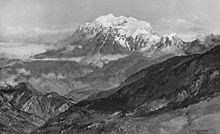Illimani
| Illimani | ||
|---|---|---|
| height | 6439 m | |
| location | La Paz Department , Bolivia | |
| Mountains | Cordillera Real , Andes | |
| Dominance | 200.27 km → Sajama | |
| Notch height | 2541 m | |
| Coordinates | 16 ° 39 ′ 14 ″ S , 67 ° 47 ′ 5 ″ W | |
|
|
||
| Type | Stratovolcano , extinguished | |
| First ascent | 1898 by the British William Martin Conway | |
| Normal way | High tour from the west side via Nido de Condores (condor nest) | |
The Illimani in the Andes in Bolivia is the second highest mountain in Bolivia at 6,439 meters and the highest of the Cordillera Real . The mountain has four peaks over 6,000 meters, the highest of which is Pico Sur. In 1898 the Briton William Martin Conway made the first ascent. As part of the German Bolivia expedition in 1950, Hans Ertl climbed the Illimani north summit single-handedly. Hans Ertl and the geologist Gert Schröder then managed to climb the Illimani south summit for the first time. In 1972, Ernesto Sanchez and Alain Mesili crossed the Illimani massif for the first time in six days.
The Illimani is a landmark for the people of La Paz . The Aymara call him “Illemana”, “where the sun was born” or “Jilir Mamani”, “the eldest son” . The left peak is also known as "Khunu Urucuncu", snow bear. According to Indian legend, the mountain ( Apu ) Mururata is said to have tried to trump the Illimani in size, whereupon the Illimani angrily cut off the snow-covered head. The severed head is said to have been located 200 km further west in the shape of the extinct Sajama volcano .
The Chilean music group Inti-Illimani is named after this mountain.
summit

The highest of the four peaks of the Illimani massif, which are over 6,000 meters high, is Pico del Indio or Pico Sur at 6,462 m . It is located in the south of the massif. The Pico La Paz or Pico Central is 6,362 m high, the Pico Kuhm or Norte 6,380 m and the Pico París 6,043 m. From La Paz the Pico del Indio (right) and the Pico Kuhm (left) can be seen.
The starting point for the ascent of all four peaks is the village of Pinaya. From here, donkeys can be used to ascend to the base camp in around two hours. The way to the Nido de los Condores high camp leads through rocky terrain and takes about five hours.
South wall
Due to the exposure towards the Amazon , the south face of the Illimani has a microclimate with changeable and isolated weather conditions. A snow storm can rage here while the sun is shining on the west side of the mountain.
The French alpinist Lionel Terray was probably the first white person to see the Illimani south face. Overwhelmed by the sight, he noted in 1952: "He who climbs the terrifying and mighty south face of Illimani has yet to be born" .
Although groundbreaking innovations in the field of alpine equipment were invented in the years that followed, it took another 20 years before the Frenchman Alain Mesili and Xavier Jaquier successfully climbed the south face for the first time in 1972.
From July 24th to 30th, 2010, the German-Austrian alpinists Florian Hill and Robert Rauch opened a completely new route on the Illimani south face and crossed other parts of the massif.
The Illimani south face is still one of the greatest challenges for Andinists.
Air accident at Illimani
On January 1, 1985, an Eastern Air Lines Boeing 727-200 crashed on flight 980 from Asunción to La Paz on Illimani. The crew probably tried to avoid a bad weather front and got off course in the process. None of the 29 people on board survived.
In the summer of 1985 an expedition reached the scene of the accident but could not find any bodies or the flight recorder . In May and June 2016, another expedition, led by Dan Futrell and Isaac Stoner, reached the crash site. They found body parts and many crocodile skins, which suggest smuggling activities on board the aircraft. They also found pieces of metal painted orange with scraps of cable marked "CKPT VO RCDR", and magnetic tapes that they thought were for the voice recorder. However, an analysis by the National Transportation Safety Board showed that it was only part of the voice recorder body and that the magnetic tapes had nothing to do with the voice recorder.
See also
Web links
Individual evidence
- ↑ Alain Mesili: "The Andes of Bolivia," Producciones CIMA, La Paz, Bolivia, 2004, ISBN 99905-79-08-3
- ↑ a b Aircraft accident data and report B-727-200 N819EA in the Aviation Safety Network (English), accessed on April 13, 2017.
- ^ Dan Futrell: The debris of Flight 980. In: Operation Thonapa. June 12, 2016, accessed on April 13, 2017 (English): " In addition to debris from the Boeing 727-225, we also found six instances of human remains "
- ↑ Isaac Stoner: An International Smuggling Ring Driven by Gross 80's Fashion. In: Operation Thonapa. May 31, 2016, accessed April 13, 2017 .
- ^ Dan Futrell: 31 years later, we found the flight recorders. In: Operation Thonapa. June 3, 2016, accessed April 13, 2017 .
- ^ National Transportation Safety Board: NTSB Completes Evaluation of Materials from Eastern Airlines Flight 980. February 7, 2017, accessed on April 13, 2017 (English).

